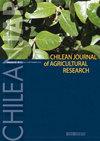Mechanisms underlying salicylic acid on root parameters and antioxidant enzyme activity of potato plant under Lelliottia amnigena stress
IF 1.7
4区 农林科学
Q2 Agricultural and Biological Sciences
引用次数: 1
Abstract
Salicylic acid (SA) plays many roles in plant physiology. In addition to pathogenesis-related resistance, SA is involved in the response to biotic stress. There are no adequate studies on mechanism underlying SA-mitigated Lelliottia amnigena infestations in potato ( Solanum tuberosum L.) plant. Therefore, this study evaluated the mechanisms of SA on antioxidant enzyme activity of potato plant roots under L. amnigena stress. The bacterial suspension (3.69 × 10 7 CFU mL -1 ) at 0.3 mL was inoculated into potato plants through stem injection. After 24 h, different SA concentrations (0.5, 1.0, 1.5 and 2.0 mM) were sprayed to the potato plants, and water as control. The results showed that L. amnigena infestation decreased fresh weight, dry weight, and relative water content of roots by 44.8%, 11.8% and 34.8%, respectively, compared to the control. The potato plant treatment with SA increased fresh weight, dry weight, and relative water content by an average of 34.88%, 10.28% and 13.50%; increased superoxide dismutase (SOD), peroxidase (POD), catalase (CAT), polyphenol oxidase (PPO), and phenylalanine ammonia-lyase (PAL) by 35.95%, 32.55%, 33.74%, 33.25%, and 38.90%; decreased malondialdehyde (MDA) and hydrogen peroxide (H 2 O 2 ) content in potato plant roots by 42.7% and 31.1%, respectively, under L. amnigena stress compared to control. Treatment with SA induced transcriptional levels of the SOD, POD, CAT and glutathione S-transferase (GST) gene expression across the four levels of SA by an average of 3.12-fold, 3.46-fold, 2.93-fold and 3.83-fold, respectively, compared to control. Salicylic acid increased antioxidant enzymes activity in roots of potato plant under L. amnigena stress. oxidative an antioxidant In our the application of to plants under L. amnigena stress the activities of antioxidant enzymes (SOD, POD, CAT, PPO, and PAL) compared to the control plants. of oxidative damage by scavenging ROS antioxidant them key the removal of hydrogen peroxide (H 2 O 2 the action of superoxide dismutase In this study, the activities of antioxidant enzymes were altered in response to SA treatment. A similar change in these enzymes also observed by However, exogenous SA restored the activities of the tested enzymes, reducing ROS and oxidative damage in potato roots. The data confirm that the key role of SA is to serve as a signaling molecule, thereby strengthening the defense system. Similar results also observed Singh et Our results suggest that exogenous SA regulates antioxidant enzymes, thereby lowering ROS and protecting potato plants from pathogen stress. In general, based on the increased activities of SOD, POD, CAT, PPO and PAL, it can be said that the treatment of SA effectively increased the antioxidants of potato plant roots to defend against the pathogen.水杨酸对遗忘型Lelliottia胁迫下马铃薯根系参数和抗氧化酶活性的影响机制
水杨酸在植物生理学中起着重要作用。除了与发病机制相关的耐药性外,SA还参与对生物应激的反应。关于SA减轻马铃薯(Solanum tuberosum L.)中遗忘叶枯病菌(Lelliottia amnigena)侵扰的机制,目前还没有足够的研究。因此,本研究评价了SA对遗忘乳杆菌胁迫下马铃薯根系抗氧化酶活性的影响机制。将浓度为0.3mL的细菌悬液(3.69×107CFU mL-1)通过茎部注射接种到马铃薯植株中。24小时后,将不同浓度的SA(0.5、1.0、1.5和2.0mM)喷洒到马铃薯植株上,并用水作为对照。结果表明,与对照相比,遗忘根的鲜重、干重和相对含水量分别降低了44.8%、11.8%和34.8%。SA处理使马铃薯植株的鲜重、干重和相对含水量分别平均增加34.88%、10.28%和13.50%;超氧化物歧化酶(SOD)、过氧化物酶(POD)、过氧化氢酶(CAT)、多酚氧化酶(PPO)和苯丙氨酸解氨酶(PAL)分别提高35.95%、32.55%、33.74%、33.25%和38.90%;与对照组相比,遗忘乳杆菌胁迫下马铃薯根系丙二醛(MDA)和过氧化氢(H2 O2)含量分别降低了42.7%和31.1%。与对照相比,SA处理诱导SOD、POD、CAT和谷胱甘肽S-转移酶(GST)基因在四个SA水平上的转录水平分别平均为3.12倍、3.46倍、2.93倍和3.83倍。水杨酸能提高马铃薯根抗氧化酶活性。氧化一种抗氧化剂在我们的应用中,与对照植物相比,amnigena胁迫下植物的抗氧化酶(SOD、POD、CAT、PPO和PAL)的活性。通过清除ROS抗氧化剂的氧化损伤它们是去除过氧化氢的关键(H2 O2超氧化物歧化酶的作用在本研究中,SA处理后抗氧化酶的活性发生了改变。这些酶也发生了类似的变化。然而,外源SA恢复了被测酶的活性,减少了ROS和土豆根的氧化损伤加强防御系统。Singh等人也观察到了类似的结果。我们的结果表明,外源SA调节抗氧化酶,从而降低ROS并保护马铃薯植物免受病原体胁迫。总的来说,在提高SOD、POD、CAT、PPO和PAL活性的基础上,可以说SA处理有效地增加了马铃薯根系的抗氧化剂以抵御病原体。
本文章由计算机程序翻译,如有差异,请以英文原文为准。
求助全文
约1分钟内获得全文
求助全文
来源期刊
CiteScore
3.00
自引率
11.80%
发文量
60
审稿时长
6 months
期刊介绍:
ChileanJAR publishes original Research Articles, Scientific Notes and Reviews of agriculture, multidisciplinary and agronomy: plant production, plant protection, genetic resources and biotechnology, water management, soil sciences, environment, agricultural economics, and animal production (focused in ruminant feeding). The editorial process is a double-blind peer reviewing, Editorial Office checks format, composition, and completeness, which is a requirement to continue the editorial process. Editorial Committee and Reviewers evaluate relevance and scientific merit of manuscript.

 求助内容:
求助内容: 应助结果提醒方式:
应助结果提醒方式:


